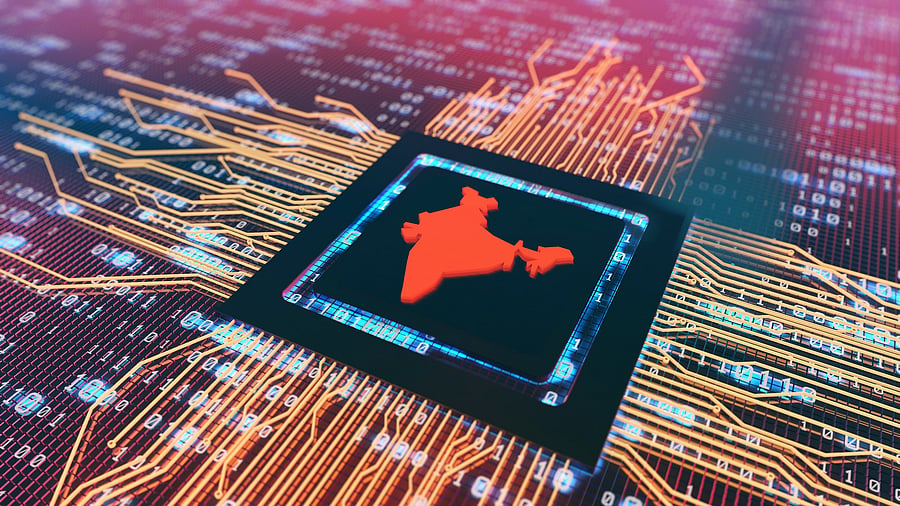
Image for representation.
Credit: iStock Photo
Chief Justice of India D Y Chandrachud, who retired on November 10, recently posed a curious question to an Artificial Intelligence (AI) lawyer at the Supreme Court’s National Judicial Museum and Archive (NJMA): “Is the death penalty constitutional in India?” The AI lawyer promptly replied that the death penalty is indeed constitutional, reserved for the ‘rarest of rare’ cases as determined by the apex court.
This interaction highlights India’s increasing adoption of AI across diverse sectors — from judiciary to healthcare, finance, education, and agriculture. AI has sparked immense interest across boardrooms and courtrooms alike. According to a report by TeamLease Digital, AI adoption in key Indian industries reached nearly 48% in FY2024.
and India’s AI market is projected to grow to $20 billion by 2028, with an annual growth rate of 26%.
IT legacy
India’s journey as an IT exporter began in the early 1970s when Tata Consultancy Services (TCS) successfully delivered hospital accounting software in partnership with the UK-based Burroughs Corporation. Soon after, companies like Infosys, Wipro, and HCL joined TCS, establishing India as a global IT powerhouse. By 2023, India’s IT and IT-enabled services exports reached an astounding $194 billion, capturing around 55-60% of the global market.
Now, India hopes to replicate this success in AI. NVIDIA CEO Jensen Huang has boldly declared that, just like in IT, India will soon export impactful AI solutions. To back this vision, NVIDIA has announced a strategic partnership with Reliance Industries Ltd (RIL) to build the data infrastructure needed.
The gigawatt challenge
India’s aspirations to become an AI exporter face significant challenges, with power demand being a major obstacle. Advanced AI applications such as large language models (LLMs) and deep learning systems require enormous computing power. RIL’s planned data centre in Jamnagar, Gujarat, exemplifies the scale of this demand. Expected to reach a capacity of one gigawatt (1,000 megawatts), this data centre will dwarf typical Indian data centres, which generally operate in the 100-200 megawatt range. To put this in perspective, one gigawatt of power can light up around half a million average Indian households.
The Jamnagar data centre will require approximately 2.5 million NVIDIA GB200 chips, which combine high-performance graphics processing units (GPUs) with advanced memory systems to handle AI’s intense computational demands. Once operational, this centre could support the training of multiple LLMs and handle real-time processing for millions of video streams worldwide.
Why chips matter
Chips, or microprocessors, are tiny slabs of silicon packed with billions of microscopic components that work together to process data. They have evolved drastically from early models, like the Intel 4004 in 1971, which could barely power a calculator, to today’s AI-focused GPUs and specialised processors.
NVIDIA’s GB200 ‘super chips’, purpose-built for AI, are said to be 30 times faster for AI tasks than previous generations, with a design that reduces power consumption by 25 times through innovations like liquid cooling. This efficiency is crucial in energy-constrained environments, making these chips invaluable for India’s AI ambitions.
Power challenges
India’s AI ambitions come with extraordinary energy demands. By 2030, AI-related infrastructure could consume an additional 100-200 terawatt-hours (TWh) per year — equivalent to the annual electricity consumption of a medium-sized country like Greece. Currently, data centres account for roughly 2% of India’s total electricity usage but this share is expected to rise to 8-15% within the next five years.
India’s energy grid remains heavily dependent on coal, which provides around 70% of its electricity. Increasing coal production to meet AI’s power needs would contradict India’s environmental goals and commitments to international climate agreements. Scaling up renewable energy is the alternative, but it presents its own set of challenges, especially given the intermittent nature of solar and wind power, and the lack of effective energy storage solutions.
Modernising India’s power grid to accommodate AI’s demands will require substantial investment in ‘smart grid’ technologies, which can dynamically manage energy flows. Such upgrades would allow the grid to handle fluctuations in renewable energy generation, ensuring a stable supply for power-hungry data centres. Without these improvements, India risks facing frequent power shortages, which could disrupt AI operations, and hinder its competitiveness on the global stage.
Building a sustainable AI ecosystem
Despite these challenges, the Indian government is committed to rapidly developing AI infrastructure. The India AI Mission, with a proposed budget exceeding $1.24 billion aims to not only build the country’s AI capabilities but also ensure they are sustainable. One unique aspect of this mission is its focus on socially viable AI applications tailored to India’s specific needs, such as in agriculture, healthcare, and language processing for regional dialects.
Additionally, the government is prioritising the development of centres of excellence to supply a steady stream of skilled workers trained to manage complex AI systems. This focus on human capital is essential, as a robust talent pipeline will be needed to operate, maintain, and innovate within India’s AI infrastructure.
The road ahead
India has the foundation and ambition to become a global AI exporter, leveraging its proven IT legacy, strategic partnerships, and growing AI market. However, significant hurdles remain, particularly in terms of power infrastructure and environmental sustainability.
Addressing these challenges will require coordinated efforts between the government, private sector, and energy providers to create a resilient and eco-friendly AI ecosystem. If India can overcome these obstacles, it stands a real chance of positioning itself as a leading AI exporter, much like it did with IT services.
(Abhishek Patni is a New Delhi-based senior journalist. X: @Abhishek_Patni)
Disclaimer: The views expressed above are the author's own. They do not necessarily reflect the views of DH.